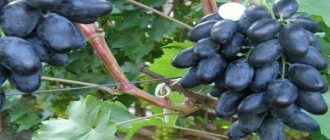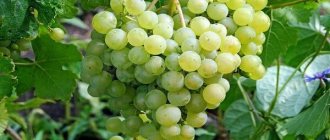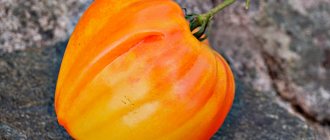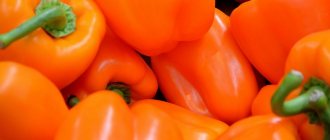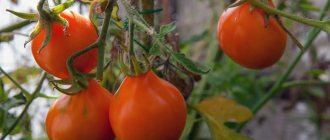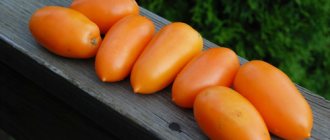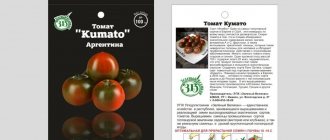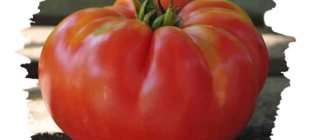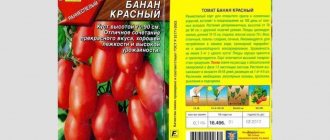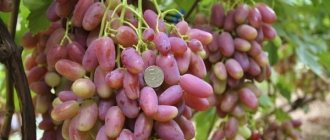Characteristics and description of the “Orange Banana” tomato indicate the mid-ripening of the variety. According to reviews from summer residents, this vegetable has excellent yield, has excellent taste and is resistant to dangerous diseases. The Orange Banana tomato variety has many positive reviews, which explains its wide popularity and high yield. The characteristics and description of the vegetable indicate that fruit ripening takes place in 110 days, the plant is not fussy to grow, but responds well to fertilization.
Characteristics and description of the Orange banana variety
The Orange Banana tomato is a mid-season variety. The duration of fruit ripening is 105-110 days from the moment of seed germination. The vegetable has many advantages and is characterized by a rich harvest, which is why it is widely popular.
The characteristics of tomato are as follows:
- The Orange Banana tomato variety is not considered a standard variety. It has a medium-sized bush, which reaches up to one and a half meters, and an average number of leaves on the branches. Outwardly, they are ordinary, somewhat reminiscent of potatoes.
- The root system and the tomato stem itself are quite powerful. The roots spread out greatly and penetrate deep into the soil, which allows the plant to extract useful microelements and essential vitamins from the soil.
- The color of the fruit is orange, the skin is thin, glossy, dense and smooth to the touch.
- According to the timing of fruit ripening, the Orange Banana tomato is classified as mid-ripening. The first fruits begin to ripen 105-110 days after sprouting.
- The tomato variety is highly resistant to common and dangerous diseases, which are late blight, cladosporiosis and fusarium.
- According to external data, the fruits of the vegetable are characterized by an unusual color. In shape, they are elongated, resembling a banana, which is why they have such a name.
Note! The weight of the fruit is small, reaching 100-120 grams, which is convenient for preservation and preparation in its entirety.
The skin does not crack during processing. The yield from a tomato bush is quite large and amounts to 3.5-4 kg.
Orange banana tomatoes are suitable for transportation; they are successfully transported over long distances. If necessary, they can ripen indoors. When storing tomatoes, it is better to use a dark, cool and dry place.
Both open ground and greenhouses are suitable for cultivation. But planting is carried out outside only if weather conditions permit.
The orange banana tomato has a true table purpose. Various dishes are prepared from the vegetable, including juices, horseradish, ketchup and consumed fresh.
Characteristics
The fruits are medium sized, about 7 cm long, about 100 g, weight, slightly ribbed. The shape of the fruit is elongated, cylindrical. The skin is smooth and thin.
You can compare the weight of Banana Orange tomatoes with others in the table below:
| Variety name | Fruit weight |
| Banana Orange | 100g |
| Diva | 120 grams |
| Yamal | 110-115 grams |
| The Golden Fleece | 85-100 grams |
| Golden heart | 100-200 grams |
| Stolypin | 90-120 grams |
| Raspberry ringing | 150 grams |
| Caspar | 80-120 grams |
| Explosion | 120-260 grams |
| Verlioka | 80-100 grams |
| Fatima | 300-400 grams |
The color of ripe fruits is interesting - pearlescent, orange. The color of newly formed fruits does not have any peculiarities; with increasing ripeness, tomatoes turn yellow.
The fleshy fruits have an average number of seeds, distributed in 2-3 chambers. The amount of dry matter is minimal. Storage for a long time in a dark place, the appearance does not deteriorate during transportation .
The variety was developed by the Russian Research Institute of Vegetable Growing in Protected Soil. Included in the State Register of the Russian Federation for greenhouse conditions in 2006. Designed for cultivation in greenhouses in any region of our country and neighboring countries. In hot countries, unhindered cultivation in open ground is possible.
The taste of the fruit is amazing - sweetish honey notes with “tomato” sourness, the vitamin content is very high. The juice from this variety has an unusually pleasant, original taste. Suitable for fresh consumption, hot dishes, pickles.
Important! Tomatoes do not lose their beneficial properties when cooked.
The small size of the fruits makes it possible to preserve them whole, which will decorate any table. The production of tomato paste and sauces is progressing successfully.
High fruit yield, uniform formation and ripening of fruits were revealed. The average yield is about 3.5 kg per plant (8-9 kg per 1 square meter).
You can compare this indicator with other varieties in the table below:
| Variety name | Productivity |
| Banana Orange | 8-9 kg per square meter |
| Grandma's gift | up to 6 kg per square meter |
| American ribbed | 5.5 kg per bush |
| De Barao the Giant | 20-22 kg per bush |
| King of the Market | 10-12 kg per square meter |
| Kostroma | up to 5 kg per bush |
| The president | 7-9 kg per square meter |
| Summer resident | 4 kg per bush |
| Nastenka | 10-12 kg per square meter |
| Dubrava | 2 kg per bush |
| Dad | 6 kg per bush |
Growing technology
Getting a rich harvest of vegetables is not at all difficult, the main thing is to follow the growing rules and carry out the necessary care for the plantings both in the open ground and in the greenhouse.
Soil preparation
It is advisable to start preparing the soil for growing orange banana tomatoes in the fall. To do this, humus or other fertilizer components should be added, which will provoke saturation of the substrate with substances necessary and beneficial for the crop.
Any tomatoes bear fruit very poorly in acidic soils, so if the pH level is high, it is advisable to take measures to reduce it. For such purposes, it is allowed to use chalk or charcoal.
In addition to humus, in the fall you should also feed the soil with potassium and phosphorus mineral compounds. Tomatoes of any variety especially love potassium nitrate, which includes nitrogen.
It is advisable to select a place for growing tomatoes in advance. When choosing a site, it is worth taking into account the illumination, temperature conditions and taking into account the predecessors who grew in this place a year ago.
Since orange banana tomatoes love full sun, it is best to plant them in an open area where there is no shade or tall buildings.
Important! When choosing a place to grow tomatoes, you should avoid lowlands, because moisture accumulates in them, which can later lead to many plant diseases.
It is prohibited to plant orange banana tomato and other varieties in areas where nightshade crops and corn grew before them. The best predecessors of such a vegetable are root vegetables, radishes, cabbage, lettuce and legumes.
Planting tomato seeds
It is recommended to plant orange banana tomato seeds in early March until the first days of April. Planting is carried out in pre-prepared containers with a special substrate, which is most beneficial for tomatoes and promotes better seed germination.
Planting seedlings in the ground
Transplantation of seedlings into a greenhouse or open ground is carried out in early June, when the plant is well formed. Before planting, you should first prepare the site, dig up the ground, and make holes.
The seedlings are immersed in the ground until the root system is hidden. When digging holes, be sure to observe the interval. Between bushes it is at least 30 cm, and between rows 50 cm.
In order to preserve the seedlings as much as possible after replanting, it is necessary to pre-harden the plants by taking them outside for a certain time so that they quickly get used to the new conditions.
Note! You can transplant tomato seedlings into the greenhouse a little earlier than outside.
Features of cultivation
A special feature is the color scheme of the skin of the fruit. The taste of “Orange Banana” is original and does not deteriorate during processing. Planting of seedlings takes place in mid-March.
The soil for planting should be low in acidity and not heavy. Seeds and soil are disinfected with a weak solution of potassium permanganate.
Planting in a common container to a depth of about 2 cm, the distance between plants is about 1.5 cm. When the first well-developed leaf appears, picking is necessary. Picking is done in a container about 15 cm in diameter; it is better to choose containers made of quickly decomposing materials (peat, paper).
There are a huge number of ways to grow tomato seedlings. We bring to your attention a series of articles on how to do this:
- in twists;
- in two roots;
- in peat tablets;
- without picking;
- using Chinese technology;
- in bottles;
- in peat pots;
- without land.
In mid-May, planting is done in a permanent place (seedlings are about 65 days old). If there is a possibility of growing in open ground, planting is done in mid-June. When planting in open ground, insulation is necessary in case of cold weather. In open ground, “Orange Banana” will bear less fruit.
Tomatoes are planted in a checkerboard pattern or in a two-row manner . The distance between plants is at least 50 cm, between rows - 60 cm.
Form the plant into one stem, removing stepsons every 10 days. Garter to vertical trellises or individual supports. Fertilizing and loosening are required .
Read useful articles about fertilizers for tomatoes:
- Organic, mineral, phosphorus, complex and ready-made fertilizers for seedlings and the TOP best.
- Yeast, iodine, ammonia, hydrogen peroxide, ash, boric acid.
- What is foliar feeding and when picking, how to carry it out.
Rules of care
Proper care plays an important role in obtaining a rich harvest, as well as protecting plantings from diseases and pests.
It is believed that it is not recommended to water vegetables for 8 days after transplanting seedlings. You can break this rule only if the weather is hot and the beds dry out quickly.
On the contrary, mature tomatoes need to be watered regularly, but weather conditions and soil conditions should also be taken into account. Watering should be carried out only in the root area, avoiding contact of water with the greenery of the plant.
Hilling up during the entire growth period of the tomato is recommended to be carried out at least 2 times. Thanks to this method, the earth is enriched with oxygen, moisture is evenly distributed over the surface and new roots are formed.
It is also very important to fertilize the tomato plant. Over the entire period, it is advisable to apply fertilizer 4 times. For this purpose, various mineral and organic compounds are used.
It is necessary to tie up the bushes, chop the plants and, if necessary, use supports as additional support for the bush.
Description
The plant is indeterminate, about 2 meters high. The stem and shoots are strong. The foliage is good. The leaves are of regular shape, medium size, light green. The inflorescences are of an intermediate type; quite a lot of ovaries are formed in them - about 10. Fruit clusters are formed through 2 leaves. Pedicel with articulation.
The fruits of the variety are beautiful, oblong in shape, smooth, dense, but in moderation. On the bush they look like a small bunch of bananas. The length of the tomato is about 8 cm, weight - 100 - 120 grams. An unripe tomato is light green and may have faint stripes; a ripe one turns a uniform bright yellow color. The pulp is fleshy, tender, juicy, contains a small amount of seeds, seed nests - 2. The dry matter content is average. The taste is excellent, the flesh is sweet.
Diseases and pests
The Orange banana tomato is characterized by high disease resistance, namely, it is immune to fusarium and cladosporiosis. To prevent late blight, which often affects tomatoes, the bushes are sprayed with copper sulfate. To prevent rot, you should organize proper watering and loosen the soil more often.
Common pests: wireworms, aphids, mole crickets and other insects are fought with both folk and traditional methods. Plants are also often sprayed, and it is recommended to sprinkle wood ash near the root system, which will repel some pests and protect the bush from fungi and other diseases.
Description
The plant is indeterminate, about 1.5 meters or higher in height. The stem of the variety is not too thick. Tomato foliage is moderate. The leaves are medium-sized, long-petiolate, regular in shape, green. Inflorescence of simple form. Fruit clusters are laid through 3 leaves. 5 - 6 clusters are formed on the main stem. There are up to 7 ovaries on one hand.
The fruits of the Orange Banana are elongated, cylindrical, smooth, and moderately elastic. An unripe tomato is light green; a ripened one turns a smooth, bright orange color. Thanks to this, the bush, decorated with ripe tassels, looks decorative. The pulp is very fleshy, with a high content of lycopene, tender, moderately dense, juicy, contains few seeds, and aromatic. The seed nests are small, numbering from 2 to 3. The tomato skin is thin and shiny. The taste of fresh fruits of this variety is excellent, you can feel the sweetness, and the sourness can slightly remind you of itself in slightly unripe tomatoes. According to the State Register, orange-fruited tomatoes are slightly larger than red-fruited ones - weighing from 85 to 92 grams.
Reviews
Raisa, 52 years old
“I’m very pleased with the Orange Banana tomato variety. The yield was good, the fruits were all the same, medium in size. It’s convenient to make salads from them, prepare various dishes and pickle for the winter.”
Maria, 39 years old
“The Orange Banana tomato is a real find. I am very pleased with the yield, the taste of the fruit is excellent with a delicate sweet and sour note. It’s not particularly fussy about growing and caring for it; it was grown in open ground.”
Alexey, 45 years old
“I liked the Orange Banana tomato variety. Seed germination was consistent, and the fruits ripened evenly. The tomatoes are elongated, fleshy, with an unusual taste and an orange-yellow hue. Good for preparing any dishes and winter preparations.”
Description
The plant is determinate, creeping, about 70 - 100 cm high. The branching is strong, the foliage is moderate. The leaves are of regular shape, medium in size, slightly corrugated, light green, with no stipule. Yellow flowers form 2 types of inflorescences - simple and intermediate. The first fruit cluster appears above the 8th - 9th leaf, the subsequent ones are laid after 1 - 2 leaves. Each brush has from 8 to 12 ovaries. Pedicel with articulation.
The tomato has a rather presentable appearance. The shape resembles a typical “cream” - the Red Banana fruit is cylindrical, smooth, and moderately elastic. An unripe tomato of this variety is light green. At the stage of consumer ripeness it turns a uniform red color. The skin is of medium density, according to reviews, sometimes even harsh, durable, glossy. The pulp is moderately juicy, fleshy, contains a large percentage of dry matter, without voids and a white core (only a few reviews indicated a slight white spot, and then near the stalk itself), and has few seeds. The number of seed chambers is 2 - 3. The State Register notes the taste qualities of fresh fruits as good and excellent. Some gardeners found the taste ordinary, even herbaceous. The weight of the fetus according to the State Register is 70 grams, according to other sources - 100 - 120 grams. It is stated that the length of the fruit can reach 10 - 12 cm, although in open ground the actual figure is almost 2 times less.
Description of the tomato variety Bananchik
The Bananchik tomato variety, the characteristics and description of which are given below, is recommended for cultivation on private farms in all regions of the Russian Federation, including the Northern regions.
Important! The Bananchik tomato is suitable for growing in open and closed ground. But in the first case, the variety is distinguished by later fruiting dates. In the middle zone, it shows the best results in terms of yield in greenhouse conditions, where it bears fruit before the onset of cold weather.
The variety is classified as indeterminate or unlimited in growth. Breeders say that the bushes reach a height of 1.6-2.0 cm. But reviews and photos of those who planted the Bananchik tomato indicate that they often grow up to 2.5 m. At the same time, the degree of formation of new shoots is below average . The plants are quite open, with a strong central stem, making them easy to care for and harvest. Despite this, you will have to find time to tie up the branches.
The leaves of the Banana tomato are elongated, rather narrow with jagged edges. The surface of the leaf blades is slightly wrinkled, rich dark green in color. Funnel-shaped buds of bright yellow color, 5-7 pieces in one bunch. The fruits ripen in the same way.
The tomato fruit is a medium-sized banana, weighing 130-150 grams. Their shape is cylindrical. There is often a slight thickening in the central part of the tomato. The dense skin at the stage of technical maturity is light green in color with blurry greenish strokes. As it ripens, it takes on a bright yellow color, which is why the variety got its exotic name. However, this opinion is slightly erroneous. According to reviews and photos provided by vegetable growers, Bananchik tomatoes turn orange if they are allowed to ripen completely.
Advantages and disadvantages of banana tomatoes
The advantages of the variety include resistance to summer weather conditions. He is not afraid of drought. This does not mean that the beds can not be watered in the heat. It’s just that Bananas can survive without watering for several hot days. What is important for our area is that tomatoes can easily tolerate a sharp drop in ambient temperature. They are not afraid of late blight.
Characteristics of varieties
All Bananas, regardless of color, have many similar properties.
- early ripeness;
- classification as table varieties;
- elongated fruit shape;
- ripening period - 90 days.
The varieties differ from one another only in weight: fruits of different colors can be from 60 g to 150 g.
- red banana weighs about 70 g;
- the orange beauty comes in 120 g;
- The weight of the yellow fruit reaches 150 g.
The red tomato of this variety has proven itself excellent in the preparation of tomato paste, dressings for main courses and various types of ketchups. A distinctive feature of the Golden Banana tomato is its use for dietary nutrition.
Advantages of the variety
The advantages of the super banana variety are obvious to everyone:
- it can be grown in all regions;
- each cluster bears about 10 fruits;
- Banana variety tomato is disease resistant and pest resistant;
- has great value in cooking;
- retains its shape during long-term transportation;
- can be grown both in the field and in greenhouses.
Benefits of the Banana variety
Along with the advantages, there are also some disadvantages that the red banana tomato has, but they are easy to deal with.
- It is recommended to grow vegetables of this variety, forming 2 trunks;
- it is necessary to remove stepsons that interfere with fruiting;
- a garter is required;
- seeds need to be treated with fungicides to prevent cladosporiasis disease.
Treatment with chemicals is carried out before sowing seeds of almost all varieties. And the care that Red Banana tomatoes require, in the form of pinching and shaping, justifies itself by increasing productivity. Without tying up tall bushes, you can lose all the fruits when they fall and break. But on supports, the Red Banana tomato looks just great in the photo.
